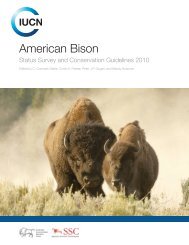Declaration Dr. Thomas H. Pringle - Buffalo Field Campaign
Declaration Dr. Thomas H. Pringle - Buffalo Field Campaign
Declaration Dr. Thomas H. Pringle - Buffalo Field Campaign
Create successful ePaper yourself
Turn your PDF publications into a flip-book with our unique Google optimized e-Paper software.
during summer rut season (Gates et al. 2005). Interestingly, Christianson et al. (2005)<br />
found significant differences in incisor wear, between female bison from the northern and<br />
central ranges of YNP suggesting limited exchange of individuals between the ranges.<br />
Differences in incisor wear were attributed to increased levels of fluoride content in<br />
vegetation and water within central Yellowstone’s geothermal areas (Shupe et al. 1984;<br />
Christianson et al. 2005)<br />
. Finally, the diverse historic origins of the Lamar Valley bison, relative to the<br />
Hayden Valley herd, may explain, in part, the differences in haplotype frequencies we<br />
observed here. By 1902, YNP’s wild bison herd had been reduced from 200-300, through<br />
illegal poaching, to about 25 animals that remained in Pelican Valley. This led to a<br />
decision to introduce 21 bison from other sources into Lamar Valley that same year<br />
(McHugh 1972; USDOI, NPS 2000; Gates et al. 2005). However, the Hayden Valley<br />
bison descended from a single translocation of 71 individuals from Lamar Valley in 1936<br />
that may not have captured the range of haplotype frequencies that were present in these<br />
bison during that time.<br />
We also observed differences in haplotype frequencies within Hayden Valley<br />
between two consecutive breeding seasons. However, we found strong differences<br />
between Hayden and Lamar breeding groups for both years (Table 3-2). A few radio-<br />
collared adult females have been observed to move between Hayden Valley and Pelican<br />
Creek during late summer and early fall (R. Wallen, Bison Ecologist, YNP, pers. comm.<br />
2007). Re-location data from YELL-024 (an adult female identified as haplotype 8),<br />
reveal movements between Hayden Valley and Pelican Creek during late summer and<br />
early fall (R. Wallen, pers. comm. 2007). The lower FST values between Mirror Plateau<br />
39










